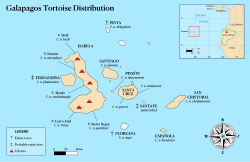Gigantic Turtle on the Island of Santa Cruz in the Galapagos
(Photographer, David Adam Kess) I took this photo on the Santa Cruz Island in the Galapagos of a World famous tortoise or Galápagos giant tortoise (Chelonoidis nigra).
Below text is from Wikipedia that describes & gives a bit of history and background to the (Chelonoidis nigra).
The Galápagos tortoise or Galápagos giant tortoise (Chelonoidis nigra) is the largest living species of tortoise and the 14th-heaviest living reptile.
The Galápagos tortoise or Galápagos giant tortoise (Chelonoidis nigra) is the largest living species of tortoise and 10th-heaviest living reptile, reaching weights of over 400 kg (880 lb) and lengths of over 1.8 meters (5.9 ft). With life spans in the wild of over 100 years, it is one of the longest-lived vertebrates. A captive individual lived at least 170 years.
The tortoise is native to seven of the Galápagos Islands, a volcanic archipelago about 1,000 km (620 mi) west of the Ecuadorian mainland. Spanish explorers, who discovered the islands in the 16th century, named them after the Spanish galápago, meaning tortoise.
Shell size and shape vary between populations. On islands with humid highlands, the tortoises are larger, with domed shells and short necks - on islands with dry lowlands, the tortoises are smaller, with "saddleback" shells and long necks. Charles Darwin's observations of these differences on the second voyage of the Beagle in 1835, contributed to the development of his theory of evolution.Relevante Bilder
Relevante Artikel
Galapagos-RiesenschildkrötenAls Galapagos-Riesenschildkröten werden 15 auf den verschiedenen Galapagosinseln endemisch vorkommende Schildkrötenarten bezeichnet. Die Galapagos-Riesenschildkröten sind kein eigenständiges Taxon, sondern bilden mit einigen Schildkrötenarten des südamerikanischen Festlands die Gattung Chelonoidis in der Familie der Landschildkröten (Testudinidae). Vier Arten der Galapagos-Riesenschildkröten gelten als ausgestorben. .. weiterlesen






